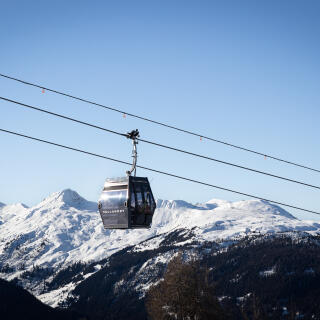


How ski resorts are trying to better protect biodiversity
NewsIn addition to climate change, ski resorts are increasingly faced with another major environmental challenge: reconciling winter sports with biodiversity conservation.
On one side was the groomed snow and the colorful procession of skiers who had come here in mid-December to enjoy the first opening days at the Les Arcs ski resort in Savoie, southeastern France. On the other, was the calm of the larch trees. Right here on the edge of the slope is where the "quiet area" of the black grouse begins, demarcated by a cordon and yellow and black signs depicting this emblematic mountain rooster.
In Les Arcs, two refuge areas have been created as part of the European Birdski program, led by the Vanoise National Park from 2020 to the end of 2023, with 26 ski resorts in Savoie and Haute-Savoie. Red flags and other beacons also flutter on the ski lift cables: Almost half of these cables have been equipped to enable birds to see them better and avoid being killed when hitting them.

Already impacted by climate change, ski resorts are increasingly faced with another major environmental challenge: Reconciling winter sports with biodiversity conservation. "Resorts have recently become more aware of their impact on wildlife," said Sandrine Berthillot, a technician at the Vanoise National Park.
The boom in off-piste activities
In recent years, over 160 black grouse quiet areas have been created in the French Alps, from the Mercantour to the Bauges and Vercors. This process marks the beginning of the ski industry's transformation, which, since the snow plans of the 1960s and 1970s, had developed around the cult of large-scale facilities and mass tourism.
It's also around that time that things started to change, without any monitoring: "The creation of resorts, sometimes from nothing on natural or pastoral environments, with their constructions, ski lifts, deforestation and terracing of slopes, represented a significant net loss of habitat for mountain fauna," explained Marc Montadert, from the research department of the Office Français de la Biodiversité (French Office for Biodiversity, OFB).
Despite being perceived as vast playgrounds, these mountains nevertheless remained inhabited: In Les Arcs, the Environmental Observatory set up in 2012 inventoried 265 animal species on ski areas, including 111 protected species. Outside the resorts, which already occupy some 300,000 hectares in France, the recent boom in off-piste activities – cross-country skiing, snowshoeing, etc. – is further increasing this human presence, which is penetrating the heart of previously isolated natural environments.

One of the most vulnerable species confronted with winter sports is the black grouse. This bird lives at altitudes ranging between 1,900 and 2,300 meters on snow-covered slopes at the edge of sparse forests, heaths and high-altitude meadows, right where the major ski resorts are located. Studies conducted in Switzerland showed that this galliform was less present in ski areas and in zones most frequented by off-piste activities.
You have 60% of this article left to read. The rest is for subscribers only.
